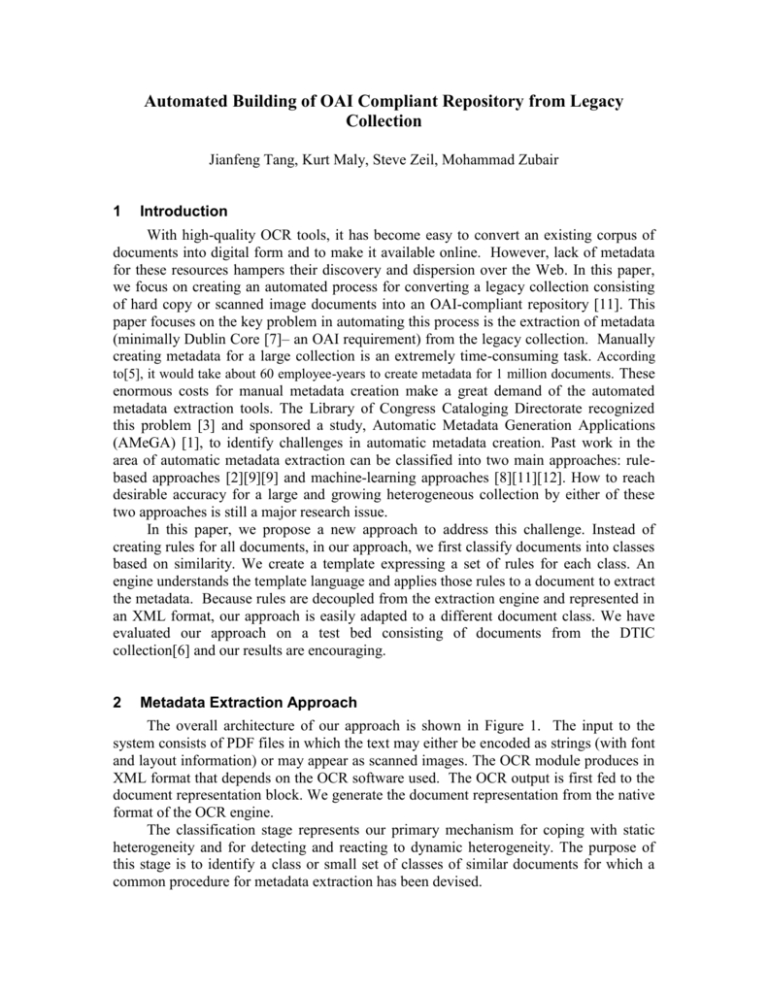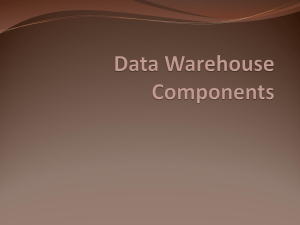metadataextrbulgaria06
advertisement

Automated Building of OAI Compliant Repository from Legacy Collection Jianfeng Tang, Kurt Maly, Steve Zeil, Mohammad Zubair 1 Introduction With high-quality OCR tools, it has become easy to convert an existing corpus of documents into digital form and to make it available online. However, lack of metadata for these resources hampers their discovery and dispersion over the Web. In this paper, we focus on creating an automated process for converting a legacy collection consisting of hard copy or scanned image documents into an OAI-compliant repository [11]. This paper focuses on the key problem in automating this process is the extraction of metadata (minimally Dublin Core [7]– an OAI requirement) from the legacy collection. Manually creating metadata for a large collection is an extremely time-consuming task. According to[5], it would take about 60 employee-years to create metadata for 1 million documents. These enormous costs for manual metadata creation make a great demand of the automated metadata extraction tools. The Library of Congress Cataloging Directorate recognized this problem [3] and sponsored a study, Automatic Metadata Generation Applications (AMeGA) [1], to identify challenges in automatic metadata creation. Past work in the area of automatic metadata extraction can be classified into two main approaches: rulebased approaches [2][9][9] and machine-learning approaches [8][11][12]. How to reach desirable accuracy for a large and growing heterogeneous collection by either of these two approaches is still a major research issue. In this paper, we propose a new approach to address this challenge. Instead of creating rules for all documents, in our approach, we first classify documents into classes based on similarity. We create a template expressing a set of rules for each class. An engine understands the template language and applies those rules to a document to extract the metadata. Because rules are decoupled from the extraction engine and represented in an XML format, our approach is easily adapted to a different document class. We have evaluated our approach on a test bed consisting of documents from the DTIC collection[6] and our results are encouraging. 2 Metadata Extraction Approach The overall architecture of our approach is shown in Figure 1. The input to the system consists of PDF files in which the text may either be encoded as strings (with font and layout information) or may appear as scanned images. The OCR module produces in XML format that depends on the OCR software used. The OCR output is first fed to the document representation block. We generate the document representation from the native format of the OCR engine. The classification stage represents our primary mechanism for coping with static heterogeneity and for detecting and reacting to dynamic heterogeneity. The purpose of this stage is to identify a class or small set of classes of similar documents for which a common procedure for metadata extraction has been devised. If classification is successful, the document mode is passed on to the metadata extractor for the selected homogenous class(es). In the literature, as well as with our own experiences, rule based systems have been found to work extremely well for homogenous collections. We propose a template-based approach to encoding what we hope will be, thanks to the successful classification, a relatively straightforward set of extraction rules. For example, a rule might say: ‘If the phrase is centered, bold and in the largest font, it is a title’. A template language allows changes to existing rules or the addition of new rules to a template for a class without having to modify the extraction engine. We now discuss in detail the two modules of this approach. OCR output of Scanned documents Document In class 1 Metadata Extraction using Template 1 Document In class 2 Metadata Extraction using Template 2 Document Classification Metadata Document In class N Metadata Extraction using Template N Figure 1. Template-based Metadata Extraction 2.1 Document Classification and Metadata Extraction In our template-based metadata extraction approach, we need to classify documents into “finer” document types. We need, for instance, to distinguish technical reports from different organizations if they used different styles. The objective of classification is to collect documents into a class homogeneous enough so that metadata extraction can succeed using a small set of simple rules. A method that can serve this purpose well is the MXY tree[4]. The primary metadata-bearing page is transformed to a MXY tree and is partitioned into m by n grid as well. In a MXY tree, each block is associated with geometric attributes such as block coordinates, text alignments in the block, etc. Each cell of m by n grid is identified as a text cell, image cell or white space cell based on whether more than half of its area is overlapped by a text block/image block or not. We classify documents into a class if they have similar MXY trees and similar m by n grid. In a template, we specify how to locate the starting point and ending point for each metadata field in a document. For example, we could specify that a “title” starts with a string with a largest font size in the top half page and ends when the font size changes; “creator” is after title and ends before a string that is not in “name format”; “date” starts with a string in date format and ends with current block.” The extraction engine understands the language in which templates are written. For an incoming document, the engine loads its corresponding template, parses the rules defined in the templates and extracts metadata from the document accordingly. Our approach also can reduce rule errors. A template for any single document class is much simpler than the rule base for all documents, and hence the chance of rule errors is lower. In addition, we can apply a template to some samples, check the results, and refine the template if necessary. In this way, we can correct errors at an early time. 3 Experiments Document Classification: The objective of this experiment is to see how many classes are needed in order to process most of the documents (75% of 7413 documents from a DTIC collection in our experiment) in a large collection. class# covered 75% docs 60 class# 50 40 30 20 10 0 0 2000 4000 6000 8000 doc# Figure 2. Document classification We observed that the function in Figure 2 is a slow growing function, appearing to grow faster than O(log N) and slower than O(sqrt(N)) where “N” is the number of documents. This is promising as it indicates we have smaller number of classes for a relatively large collection. Template-based experiment: We randomly selected 100 documents from the DTIC collection consisting of more than 70,000 documents [6] and manually assign documents to document classes based on their layout information. After ignoring classes with very few documents, we obtained seven document classes with 73 documents in all. Then we created one template for each document classes and applied our template-based module to these documents. Precision was 100% with two fields in one document in two classes having errors. Recall was similarly 100% with the exception of 5 documents in one class having only 90-96% and two other documents having 66%-83%. We also compared our results with learning techniques like SVM. 4 Conclusions We propose our metadata extraction approach to address the challenge of getting desirable accuracy for a large heterogeneous collection of documents. In our approach, we first assign documents into groups based on similarity. We create a template for documents in each group instead of all documents. We obtained promising results with our initial experimentation. One of our future works is to integrate the classification and template based metadata extraction to automate the entire process. 5 [1]. [2]. [3]. [4]. [5]. [6]. [7]. [8]. [9]. [10]. [11]. [12]. [13]. References AMeGA, Automatic Metadata Generation Applications, Retrieved April, 2005 http://ils.unc.edu/mrc/amega.htm Bergmark D. Automatic Extraction of Reference Linking Information from Online Documents. CSTR 2000-1821, November 2000. Bibliographic Control of Web Resources: A Library of Congress Action Plan, Retrieved April, 2005, http://www.loc.gov/catdir/bibcontrol/actionplan.html Cesarini F, Lastri M, Marinai S, and Soda G. Encoding of modified X-Y trees for document classification. In Proc. Sixth ICDAR, pages 1131–1136, 2001. Crystal A and Land P. Metadata and Search: Global Corporate Circle DCMI 2003 Workshop. Seattle, Washington, USA, 2003. Retrieved April 3, 2004, from http://dublincore.org/groups/corporate/Seattle/ DTIC Collection: http://stinet.dtic.mil/str/index.html Dublin Core Metadata Initiative (DCMI), http://dublincore.org/. Han H, Giles CL, Manavoglu E, Zha H, Zhang Z, and Fox EA. Automatic Document Metadata Extraction Using Support Vector Machine. 2003 Joint Conference on Digital Libraries (JCDL'03), Houston, Texas USA, May 2003. Kim J, Le DX and Thoma GR. Automated labeling algorithms for biomedical document images. Proc. 7th World Multiconference on Systemics, Cybernetics and Informatics, Vol. V, pages 352-57, Orlando FL, July 2003. Klink S, Dengel A, and Kieninger T. Document structure analysis based on layout and textual features. In Proc. of Fourth IAPR International Workshop on Document Analysis Systems, DAS2000, pages 99--111, Rio de Janeiro, Brazil, 2000. Lagoze C, Sompel H, Nelson M, and Warner S. The Open Archives Initiative Protocol for Metadata Harvesting. 2003. Retrieved April, 2005, from http://www.openarchives.org/OAI/openarchivesprotocol.html. Mao S, Thoma G. Bayesian Learning of 2D Document Layout Models for Automated Preservation Metadata Extraction. Proc. of the Fourth IASTED International Conference on Visualization, Imaging, and Image Processing (VIIP), September 2004. Seymore K, McCallum A, and Rosenfeld, R. Learning hidden Markov model structure for information extraction. In AAAI Workshop on Machine Learning for Information Extraction, 1999.






